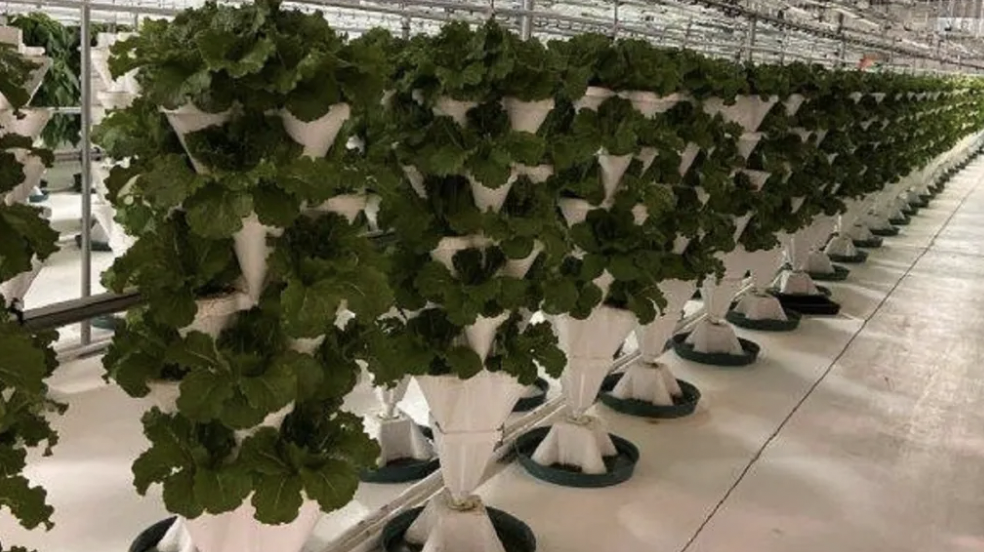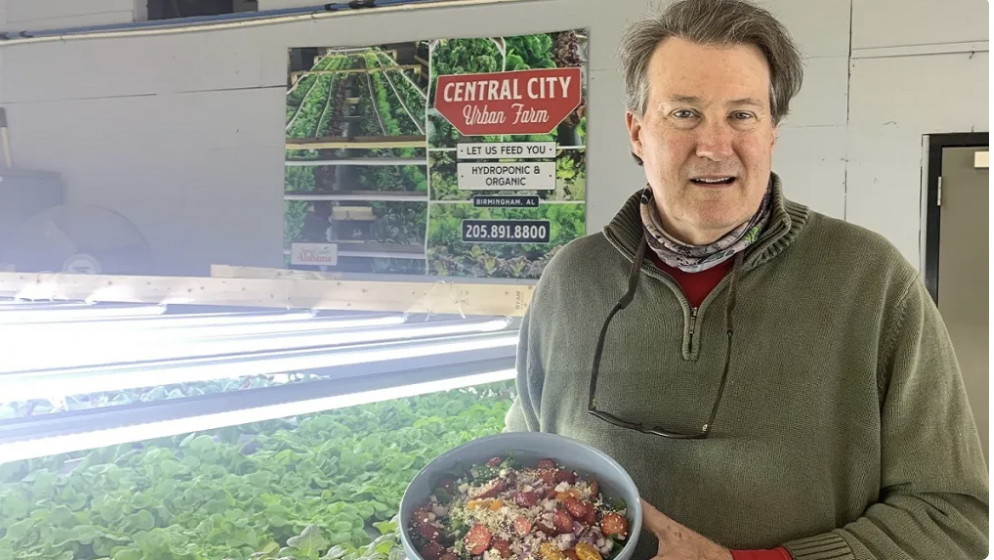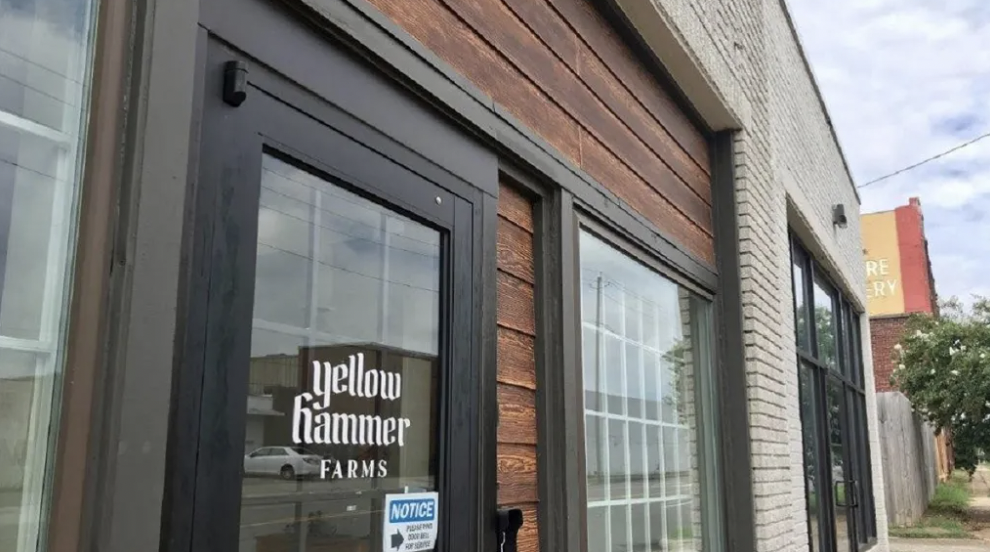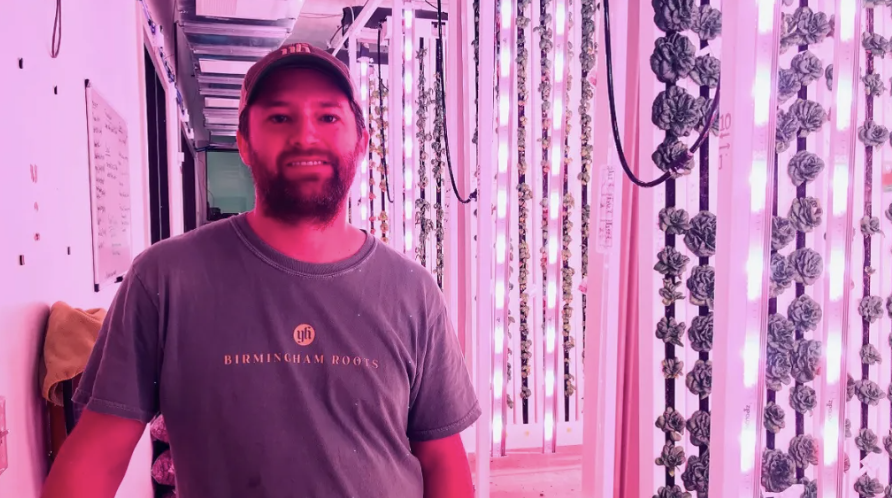Indoor, Hydroponic Farms Sprouting Across Alabama
By Michael Sznajderman
Alabama NewsCenter
August 30, 2022
Harvesting fresh produce, grown indoors at Birmingham's Yellow Hammer Farms. (Michael Sznajderman / Alabama NewsCenter)
It’s a growing business in Alabama that is sowing a different kind of agriculture – and helping meet the expectations of polished palates, healthy eaters and people struggling with food insecurity.
Hydroponic farms and gardens are cropping up in urban and rural Alabama settings, supplying grocery stores, restaurants and nonprofits with fresh produce while using less water and chemicals than traditional methods.
“It’s so exciting,” said Fran Fluhler, director of the nonprofit Manna House in Huntsville, which uses its 15,000-square-foot indoor hydroponic garden to grow 6,500 heads of romaine lettuce every month, plus bushels of succulent, blue lake green beans. Manna House uses its own-grown bounty, as well as fresh produce, meat and food staples that they purchase, to help nourish needy families across the Rocket City region.
Fluhler grows her vegetables in Hydro-Stackers – white, polystyrene towers that stand roughly 5 feet tall, each one holding multiple plants. Because her lettuce is grown in water – no soil at all – she said it’s safer to consume by people with suppressed immune systems or other health issues who must avoid contracting bacteria-related illnesses from raw vegetables. Like other indoor hydroponic farms, Fluhler uses LEDs as an alternative to natural sunlight.
An unabashed advocate for hydroponics, Fluhler eagerly shares information and provides tours to people curious about the process – whether they want to start a commercial operation or are simply interested in creating a personal container garden on the corner of their porch.
Lettuce growing at Manna House’s indoor hydroponic farm in Huntsville. (contributed)
“I’m all about growing it forward,” Fluhler quips. Beyond the Manna House mission of sharing healthy food with families struggling to make ends meet, Fluhler says, “my purpose for us is to train and educate people in hydroponics, so they will start their own hydroponic garden – at home, or anywhere.”
Hydroponic farms in the heart of the city
Some 90 minutes south of Huntsville, just a few blocks west of Interstate Highway 65 and downtown Birmingham, there’s another hydroponic farm – nestled inside an unassuming warehouse. It grows a range of leafy greens and herbs that are snatched up quickly by local chefs and customers shopping in Piggly Wiggly stores.
Yellow Hammer Farms uses a different method than Field of Greens; it grows its produce vertically. The farm’s several varieties of lettuce, watercress, parsley and herbs – including lemon basil, oregano, rosemary and thyme – bloom sideways on about 2,000 square feet of floor space, each plant nestled within specially designed towers under LEDs. The vertical method allows for more plants to be grown in tighter spaces, with driplines providing them precisely enough nutrient-enhanced water to thrive.
Like Fluhler’s operation, the amount of water needed at Yellow Hammer Farms is a fraction of what’s required to grow plants commercially outdoors – typically about 95% less. And Yellow Hammer Farms’ owner, Frank Fitts IV, is refining the system to filter and recycle water from the building’s air conditioners – which will reduce water usage even further.
In addition to supplying produce to local retailers and restaurants, Yellow Hammer Farms operates a storefront at the warehouse. One of the best sellers is “Olive’s Spicy Mix,” a medley of greens “with a little kick,” named after the family dog. Over the course of a year, Yellow Hammer Farms can match the harvest of an outdoor, 15-acre field, depending on the crop, Fitch says.
Yellow Hammer Farms isn’t the only hydroponic produce supplier in the Birmingham area. Down the same avenue, about 20 blocks east, Central City Urban Farm uses a hydroponic system to grow lettuce, kale, Swiss chard, spinach, basil, chives and cilantro. More than 5,000 square feet of Central City’s 25,000-square-foot facility is devoted to hydroponic farming. Here, the plants grow horizontally.
Fresh salad, courtesy of Central City Urban Farm in Birmingham. (contributed)
It, too, provides fresh produce to local Piggly Wiggly stores and sells directly to consumers through Market Wagon.
Mitch Hungerpiller, owner of Central City Urban Farm, says one of the biggest draws of hydroponic vegetables and herbs is the quality and freshness of the product, which typically costs more to grow than food coming from large-scale, conventional farms.
“There’s not a single chef, not a single consumer, that has told me they don’t love the freshness, the taste, the quality,” says Hungerpiller, whose family has farmed for generations.
He and Fitts say their hydroponic wares will stay fresh longer than traditionally grown produce found in groceries or supplied by food distributors, which is appealing to Birmingham’s award-winning restaurant chefs.
As for average consumers, however, Hungerpiller says there’s still a learning curve about hydroponically grown produce and the value that comes with the higher price.
Fitts, too, says his produce can be “a little more expensive – as with anything that’s handcrafted.” But once customers try it, they recognize and appreciate the freshness and flavor. “They think it’s superior.”
Fancy greens for fancy eaters
Another 90 minutes down the road from Birmingham, in Montgomery, another style of hydroponic farming is feeding cultured appetites at one of the city’s beloved upscale restaurants.
The Vintage Hospitality Group, which operates Vintage Year and other popular Montgomery eateries, grows its greens hydroponically out of two customized shipping containers stacked on each other in back of its namesake restaurant. It calls the operation MGM Greens.
MGM Greens’ double-stack of Freight Farms containers. (contributed.)
It evolved from a partnership with Alabama Power, which was testing an indoor farming container constructed by Boston-based Freight Farms as part of the company’s research into indoor agriculture. After the research was completed, the container was transported to Montgomery from Alabama Power’s Technology Applications Center in Shelby County. MGM Greens purchased a second Freight Farms container to create the two-story farm.
Inside the containers is a vertical farm – similar to the system used by Yellow Hammer Farms – but in a more compact space. This type of self-contained farming, in structures that can be easily transported, opens up opportunities for food production in places that won’t sustain large-scale outdoor farms, including in very dry climates, or in densely populated urban neighborhoods with limited or pricey real estate, or in communities considered “food deserts,” with no nearby access to full-service grocery stores.
Bringing food production closer to population centers – through containerized or other indoor and hydroponic agriculture – can help cut transportation costs, along with the environmental impacts of shipping produce from distant farms or across international borders.
“I think it’s a big trend,” says chef Eric Rivera of Vintage Hospitality Group. For his restaurants, MGM Greens offers greater control over the quality and freshness of what Rivera serves his discriminating clientele. “If we decide we need arugula today, we can harvest it, and that evening it’s on your plate.”
Yellow Hammer Farms grows its crops indoors, smack dab in the city. (Michael Sznajderman / Alabama NewsCenter)
On the other hand, he adds, hydroponic farming is no panacea. While indoor farming provides one clear benefit over the outdoor version – protection from unpredictable weather – there are plenty of adverse things that can happen – from equipment failures to power outages.
“It’s still farming,” Rivera says. “There’s always ups and downs. We still have our challenges.”
He notes that some schools, food service companies and larger agricultural institutions are beginning to embrace indoor and hydroponic farming to help reach sustainability goals; meet growing demand for fresh and local food; or to capitalize on the ability of indoor farms to supply seasonal produce 365 days a year.
Auburn University’s Department of Horticulture, for example, has incorporated Freight Farms containers as part of its student-run campus farm. Produce from the containers are sent to campus dining facilities as part of the university’s efforts to consistently provide fresh and healthy food options to students and faculty. The horticulture department is also working with Alabama Power to monitor MGM Greens’ ongoing operation and assess its long-term viability.
Back in Huntsville, Fluhler has helped area college students learn about hydroponics. She provided 10 Hydro-Stackers to the University of Alabama in Huntsville; the produce grown by students there go to local restaurants, she says.
She is excited about the expanding research into sustainable agriculture taking place at the nearby Hudson Alpha Institute for Biotechnology, which recently built a state-of-the-art greenhouse with LEDs for growing plants hydroponically.
Fluhler, Fitts and Rivera say there’s room for indoor and hydroponic agriculture to continue to grow in Alabama.
Under the LEDs with Frank Fitts IV of Yellow Hammer Farms. (Michael Sznajderman / Alabama NewsCenter)
Fitts says the relatively low cost of warehouse space and energy in Alabama, compared to many other states, is a plus, as is the growing demand among Alabamians for healthy food options and farm-to-table dining. He envisions more specialty operations – mushroom growers, for example – getting into hydroponic farming.
On the other hand, like many enterprises, supply chain issues are causing some challenges for indoor and hydroponic farmers, Fitts says. And he agrees with Rivera: No matter what kind of farming you do, it’s not easy.
Fitts says he’s always willing to share what he’s learned with others who are interested in the business. He notes a recent conversation with folks doing hydroponic farming in Baldwin County; a quick Google search reveals at least two operations in that south Alabama county using hydroponics: The Hope Farm and Local Appetite Growers.
“I do think we will see more establish themselves in the business,” Fitts says.







